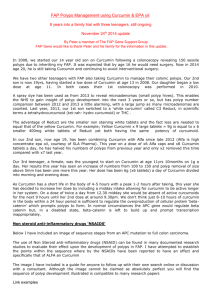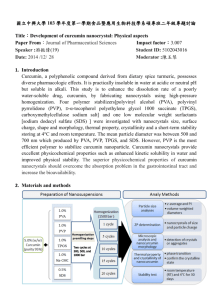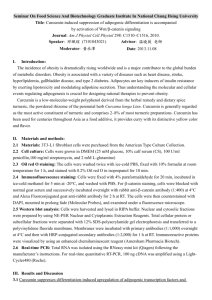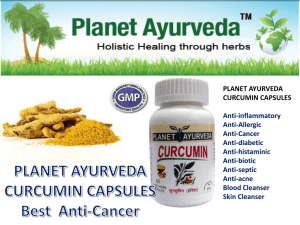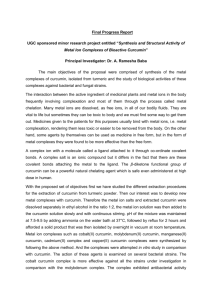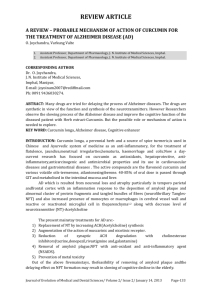2015 final Curcumin Personal Trial
advertisement
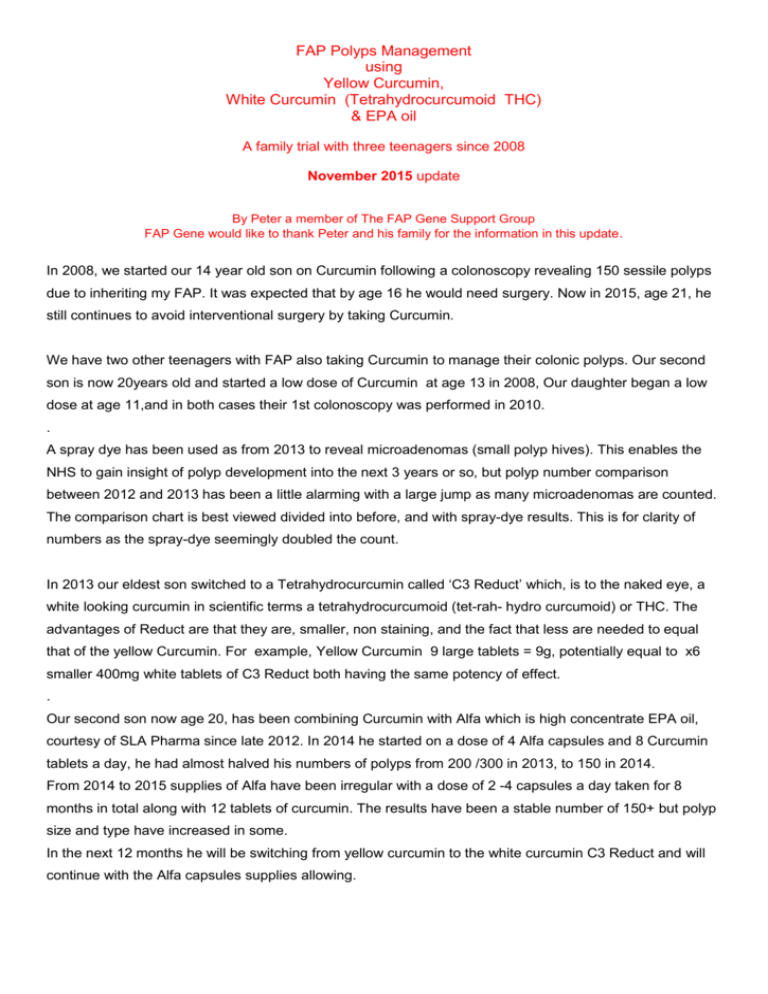
FAP Polyps Management using Yellow Curcumin, White Curcumin (Tetrahydrocurcumoid THC) & EPA oil A family trial with three teenagers since 2008 November 2015 update By Peter a member of The FAP Gene Support Group FAP Gene would like to thank Peter and his family for the information in this update. In 2008, we started our 14 year old son on Curcumin following a colonoscopy revealing 150 sessile polyps due to inheriting my FAP. It was expected that by age 16 he would need surgery. Now in 2015, age 21, he still continues to avoid interventional surgery by taking Curcumin. We have two other teenagers with FAP also taking Curcumin to manage their colonic polyps. Our second son is now 20years old and started a low dose of Curcumin at age 13 in 2008, Our daughter began a low dose at age 11,and in both cases their 1st colonoscopy was performed in 2010. . A spray dye has been used as from 2013 to reveal microadenomas (small polyp hives). This enables the NHS to gain insight of polyp development into the next 3 years or so, but polyp number comparison between 2012 and 2013 has been a little alarming with a large jump as many microadenomas are counted. The comparison chart is best viewed divided into before, and with spray-dye results. This is for clarity of numbers as the spray-dye seemingly doubled the count. In 2013 our eldest son switched to a Tetrahydrocurcumin called ‘C3 Reduct’ which, is to the naked eye, a white looking curcumin in scientific terms a tetrahydrocurcumoid (tet-rah- hydro curcumoid) or THC. The advantages of Reduct are that they are, smaller, non staining, and the fact that less are needed to equal that of the yellow Curcumin. For example, Yellow Curcumin 9 large tablets = 9g, potentially equal to x6 smaller 400mg white tablets of C3 Reduct both having the same potency of effect. . Our second son now age 20, has been combining Curcumin with Alfa which is high concentrate EPA oil, courtesy of SLA Pharma since late 2012. In 2014 he started on a dose of 4 Alfa capsules and 8 Curcumin tablets a day, he had almost halved his numbers of polyps from 200 /300 in 2013, to 150 in 2014. From 2014 to 2015 supplies of Alfa have been irregular with a dose of 2 -4 capsules a day taken for 8 months in total along with 12 tablets of curcumin. The results have been a stable number of 150+ but polyp size and type have increased in some. In the next 12 months he will be switching from yellow curcumin to the white curcumin C3 Reduct and will continue with the Alfa capsules supplies allowing. Our Third teenager, a female, was the youngest to start on Curcumin when she was 11years and 10 months old on 1g a day. Her results in 2015 are stable at 150 as found in 2014. This year she has donated 15 polyps to the Oxford Radcliffe Biobank for research study. Her dose regime of 3g twice a day in 2013 & 2014 may have contributed to the small elevated number of 50. In an attempt to prevent any more rise in numbers for 2015, she has changed her dose numbers from two to now three times a day (2g; 2g; 2g ) with polyp numbers now remaining at 150 for this year. Curcumin (yellow) has a short life in the body of 4-5 hours with a peak 1-2 hours after taking. A dose of twice a day may not be sufficient to regulate the overproduction of cellular protein ‘beta-catenin’. A dose split into three times a day has the active curcumoids in the body for a longer period of time to manage the beta-catenin. In normal circumstances the APC gene would regulate beta catenin, but in a disabled state beta-catenin is left to be unhindered in production and prompt transcription inappropriately to develop polyp formations. This year she also tried out the Alfa capsules for 6 months to see if any digestive problems occurred for future consideration and no real issues have developed if taken with food. Male 1 Year 2008 Polyp Numbers Age 100-150 14 x1 Removed 150 Yellow curcumin 2g –3g a day divided into four doses 14 2008 x7 biopsied Yellow curcumin (9months later) 2010 Dose used to gain result 2grammes a day. (500mg four times a day) 50 16 all below 2mm Yellow curcumin 2g a day (500mg four times a day) 2012 250-300 18 x200 pedunculated x 1 removed 2012 100 (6 months later) Yellow curcumin 2g a day (500mg four times a day) 18 x50 pedunculated Yellow curcumin 8g a day (Divided 3g ; 2g ; 3g) Spray-dye used from 2013 2013 Spray-dye is used to reveal microadenomas that would otherwise not be seen in previous colonoscopies. The new comparison starts here. 200-300 19 Yellow curcumin 8g a day (3g; 2g; 3g) 20 White curcumin has been taken for this years results. zero pedunculated 2014 200+ zero pedunculated x4 removed white curcumin (Tetrahydrocurcumoid THC) Product name ‘C3 Reduct’ by Sabinsa.corp x5 400mg Reduct tablets (2g of Reduct tablets equal potency of 7.5g of Yellow curcumin) White curcumin 2015 100+ 21 zero pedunculated few 5mm removed x8 Reduct tablets (3200mg) Equivalent potency of 12g of yellow curcumin Plus tried Alfa capsules 2g (x4 capsules) for 6 months Male 2 Year 2010 Polyp Numbers 80-100 Age Dose used to gain result 15 1.5g a day (500mg three times a day) 16 1.5g a day(500mg three times a day) 17 3g a day first 6 months then 6g a day 18 6g curcumin ( 2g three times a day) x1 pedunculated x 1 removed 2011 100 Biopsies taken 2012 100 x1 pedunculated removed Spray-dye used from 2013 2013 Spray-dye is used to reveal microadenomas that would otherwise not be seen in previous colonoscopies. The new comparison starts here. 200-300 x 7 removed over 5mm Plus 1g Alfa capsules (x1 twice a day) 2014 150 19 8g curcumin ( 2g four times a day) x 2 removed over 5mm Plus 2g Alfa capsules (x1 four times a day for 10 months) 2015 150+ 20 x5 reaching 1cm Increasing numbers of pedunculated up to 7mm 12g a day ( 3g four times a day) Plus 1g / 2g Alfa capsules (for a 8 month duration) Female Year 2010 Polyp Numbers Age 50-60 Dose used to gain result 13 1g a day (500mg twice a day) 14 1g a day 15 3-6g a day (1.5g- 3g twice aday) Several biopsies taken 2011 50-55 (500mg twice a day) x16 pedunculated removed 2012 40 x 4 biopsies taken no mention of pedunculated Spray-dye used from 2013 2013 (spray-dye) Spray-dye is used to reveal microadenomas that would otherwise not be seen in previous colonoscopies. The new comparison starts here. 100 16 6ga day (3g twice a day) 17 6g a day (3g twice a day) 18 6g a day (2g three times a day) x 5 removed for biopsies x2 semi-pedunculated 2014 (spray-dye) 150 x6 removed over 5mm no mention of pedunculated 2015 150+ x15 removed for the Radcliffe Bio Bank (research ) none 1cm Tried Alfa capsules x2 a day 1g for 6 months Non steroid anti-inflammatory drugs ‘NSAIDs’ Below I have included an image of sequence stages from an APC mutation to full colon carcinoma. The use of Non Steroid anti-inflammatory drugs (NSAIDs) can be found in many documented research studies to evaluate their effect upon the development of polyps in FAP. I have attempted to establish the points within the sequence stages where by the NSAIDs have been reported to have an effect, specifically that of Alfa and Curcumin. The image I have included is a guide for anyone wishing to follow up with their own search online or discussion with a consultant. Although the image cannot be claimed as absolutely perfect, you will find the sequence of polyp development illustrated is compatible to many scientific research papers. Link examples http://syscol-project.eu/wp-content/uploads/2011/11/ab_stor.gif http://www.scielo.br/img/revistas/ag/v42n2/a07fig02.gif http://www.bu.edu/synapse/files/2011/01/cancerprogression.png NSAIDS (Non-steroidal anti-inflammatory drugs) Normal epithelium APC loss Chromosome 5q NSAID S Curcumin Dysplastic cells COX-2 overexpression NSAID Curcumin S & Alfa Early adenoma k-ras activation Chromosome12q NSAID S Curcumin Intermediate adenoma SMAD4 loss Chromosome18q Late adenoma TP53 loss Chromosome 17p NSAIDS Carcinoma Curcumin (upregulates protein P53) Overview It has become clear over the years that each person has their individual level of accelerated polyp expression and this makes it impossible to predict similar results in each if relying on a fixed flat base dose. In each case there requires an individual progress evaluation and adjustment to the dose. Looking at the three cases, it does seem that curcumin and Alfa can be given credit in managing our teenagers FAP polyps expression over the last few years. Other than a few polyps removed during the colonoscopy, there has been no surgery performed on any of their colons from the first colonoscopy in February 2008. The general trend seems to be a stable situation with a reduction in two since 2013. Regarding side effects, in our experience, if a dose is introduced slowly at first, young teenagers can tolerate curcumin very well, even at high doses of 8-12 grammes a day. The worst side effects are slightly looser stools, which can be resolved by eating an egg in the morning, and mild nausea or stomach ache if taken on empty stomach - especially first thing in the morning. Alfa capsules have not caused any negative reactions, but once again avoid on an empty stomach, yet if you decide to bite the capsule, the epa oil can have a chilli sting effect on the tongue. Curcumin The curcumin and Reduct we use is ‘curcumin C3 complex’ and ‘C3 Reduct’, both products produced by Sabinsa.corp. Curcumin is sold under many known brand names with the links listed on this site: ‘curcumin suppliers’. We can only recommend the use of the Sabinsa product as it is produced to a high standard, absent of microbes,and delivering 95% active curcumoids from processed Asian spice tumeric. Standard turmeric on the shelf only delivers approximately 5-10 % active curcumoids. It is worth a note; UK human clinical trials in Leicester only use the Sabinsa product due to its many years of proven high quality. C3 Reduct This is a Tertahydrocurcumoid (THC). Curcumin in the human intestine is converted into tetrahydrocurcumin by E. coli and that the resulting tetrahydrocurcumin is responsible for various activities associated with curcumin in the human body.In addition to the intestinal resident E. coli, curcumin is also metabolized by other reductive enzymes in human body to tetrahydrocurcumin, thus THC is far more bio-available,- easier to be absorbed in to the body. The potency of THC can make it more upsetting to the stomach if sensitive or without food. We have found taking two tablets (800mg) comfortable, but taking three in one dose can evoke a feeling of needing to go to the toilet after 90minutes, either being just gas bloating, or a genuine need to go to the toilet. Contact Sabinsa.corp http://www.sabinsa.com/contact/contact-sabinsa-usa.aspx Website Link http://www.sabinsa.com/products/standardized-phytoextracts/c3/ Website Link http://www.c3reduct.com/ Website Link http://www.sabinsa.com/products/faq/c3reduct/ Alfa Capsules Alfa capsules are a concentration of EPA fish oil produced at a high standard and supplied by SLA Pharma, available on prescription through a consultant. Website Link http://www.slapharma.com/ More info of the clinical trial of Alfa EPA oil: http://www.clinicaltrials.gov/ct2/show/NCT00432913?term=S.L.A%2BPharma&rank=4 We would like to thank the Oxford Genetic department for all their support and expertise in working with us to maintain a safe working practice in our personal exploration of curcumin& Alfa Capsules An update will be in 12 months. If anyone wishes to know more details, please contact Mick Mason who will forward my contact e mail mickmason@fapgene.com Mick Mason Secretary The FAP Gene Support Group Tel 01664-566101 12 Freeby Close Melton Mowbray Leicestershire LE13 1HN
